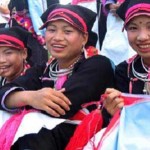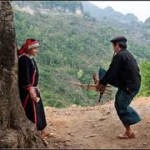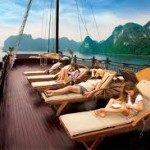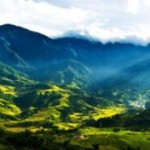Dien Bien Phu overview
Introduction
Dien Bien Phu is famous as a battlefield that was truly decisive. The French colonial forces were roundly defeated at the hands of the Viet Minh on 7 May 1954 and the days of their Indochina Empire were finally numbered.
Like Hanoi and Ho Chi Minh City, Dien Bien Phu now enjoys the prestigious status of provincial city, although it is not quite in the same league. Set in one of the most remote parts of Vietnam, the town is 34km from the Laos border in the flat, heart-shaped Muong Thanh Valley, surrounded by steep, heavily forested hills. The size and look of the city is surprising considering the remote location, especially if you managed to survive getting here overland.
History is the main attraction in Dien Bien Phu and the scenery is more stunning on the journey to or from Dien Bien Phu than around the town itself. Not surprisingly, the majority of travelers who come here now are French – Dien Bien Phu seems to hold the same sort of fascination for them as the Demilitarized Zone (DMZ) does for Americans.
For a long time Dien Bien Phu is also a point of cultural and economic exchange between people in the border area of Vietnam, Laos and China, it was also an area of power dispute between land lords.
The area is inhabited by Montagnards, most notably the Thai and H’mong. The government has been encouraging ethnic Vietnamese to settle in the region. So visiting Dien Bien Phu, travelers not only visit the historical battlefield, but also have something in mind about the life of local people here.
How to get there
The overland trip to Dien Bien Phu can be more intriguing than the actual battlefield sites for which the town is so celebrated. Of course, you miss out on this if you fly.
Land
Bus
The bus station is on Highway 12, at the corner of Tran Dang Ninh. There is a direct bus service that runs from Hanoi to Dien Bien Phu (14 hours) leaving at 6am and 8am.
Buses to Muong Lay (three hours) leave in the morning. Daily buses to Son La (four hours) start at 4.30am, but for normal people who like to get up at normal times there are regular departures until noon.
Although the bus is cheap, it’s not really much fun. Buses are so packed that the only scenery you get to admire is the armpit of the person sitting next to you. If overloaded vehicles, bad roads and bad brakes worry you, definitely fly or travel overland by 4WD or motorbike.
Car & motorbike
The 470km drive from Hanoi to Dien Bien Phu on Highway 6 and 42 takes at least 12 hours (if you’re lucky). Conceivably it could be done in a single direct journey, but almost everyone stays overnight in Son La. Speaking from experience; it’s no picnic hanging on to the hairpins on a motorbike in the dark!
Air
Vietnam Airlines (824 948; fax 825 536; 7.30-11.30am & 1.30-4.30pm) operates daily flights between Dien Bien Phu and Hanoi. The office is just before the airport, about 1.5km from the town centre, along the road to Muong Lay.
What to see
Dien Bien Phu Vestiges
Command bunker of French General De Castries
Lying in the heart of the entrenched camp of Dien Bien Phu, Command bunker of General De Castries is kept intact the original shape, dimension, structure and arrangement of the bunker. In Dien Bien Phu entrenched camp; the command bunker was the place where Vietnamese troops fought bravely during fifty four days and nights to get inside. With twenty meters in length and eight meters width, the bunker consists of 4 compartments, which served as both working offices and resident places. Travelers come here now can still find the iron vaults and sandbags on the top of the bunker.
Muong Thanh Airfield
Muong Thanh Airfield used to be served as the stronghold 206 and the central airport of the entrenched camp of Dien Bien Phu in 1954. Presently, the name “Muong Thanh” has been changed into Dien Bien Airfield. This is one of the destinations in the flight system of the Vietnam Civil Aviation. Tourists traveling to Dien Bien by air will land at this airport.
Hill A1
Hill A1 is situated in Muong Thanh ward in Dien Bien Phu City. It possesses three defense lines. One of them which stretched from the Cay Da blockhouse and protected the way to the hilltop has currently been the main road leading to the top of Hill A1. Hill A1 played an important role in controlling the whole battle of Dien Bien Phu. Tourists can easily realize a hole atop Hill A1 – which resulted from the pressure of an explosion in Dien Bien Phu Battle. This hole has become one of the most tourists’ attractions.
Besides Hill A1, from afar tourists can easily recognize the names of some hills named Doc Lap, Him Lam, Hill C, D and E. They are now well-preserved by Dien Bien People and Authorities.
The cemeteries in Hill A1 and Doc Lap Hill
When traveling to Dien Bien, almost French veterans who used to take part in the entrenched camp of Dien Bien Phu will spend time visiting the cemeteries in Hill A1 and Doc Lap Hill. This is the resting place of Vietnamese soldiers who heroically sacrificed in fighting against the French troops in 1954. It is estimated that there are 644 tombs at Hill A1 and 2432 tombs at Doc Lap Hill.
The Command post of the Vietnamese soldiers
It is located in a primitive forest in Muong Phang Commune. Tourists visiting here have chance to find the hut where Vietnamese General Vo Nguyen Giap worked and other huts for information and military operation discussion.
Here are the historical sites of the fifty six days and nights fierce battle of Vietnamese troops and Vietnamese people, which results in the glorious victory of Dien Bien Phu in 1954.
Pa Khoang Lake
Pa Khoang Lake is located in Muong Phang commune, Dien Bien district. The position of this lake is very convenient for a visit, near the road 279, about 20 km from Dien Bien Phu city, linking Dien Bien Phu city with Muong Phang historical and cultural forest where the relics of the Command of Dien Bien Phu compaign remains.
The Pa Khoang tourist complex covers an area of 2,400 ha, in which 1,320 ha of forest area, 300 ha of farming land, 150 ha of basic construction, and 600 ha of water surface area (the lake contains about 37.2 million m3 of water). This area possesses several favorable conditions for tourist activities such as diverse plants, various topography, good weather, etc. There are a number of animals and various kinds of orchids in the forest around the lake. There are also many species of fish and floating plants in the lake (about 65 kinds of floating plants, 14 species of floating animals and 6 species living at the bottom of the lake).
Pa Khoang Lake is lying in the centre of ranges of mountains, in the place of beautiful natural sceneries. In spring, mist covers ranges of mountains and small houses which create a mysterious picture. In summer, the weather is quite nice with blows of cool wind. Visitors coming here can enjoy the natural beauty in the distance or row a boat for sight-seeing. All makes a peaceful and romantic picture attractive to visitors.
In the lake region, there are the villages of Thai and Kho mu ethnic groups who still follow traditional customs and habits of ethnic groups in the North West of Vietnam. This is also an interesting human tourist potential, waiting for tourists to explore.
Pha Din Pass
To reach Dien Bien province from Hanoi, travelers have to pass Pha Din pass that is about 32 km long. In the local language, Pha Din means heaven and earth. According to a local legend, Pha Din Pass is the place where the sky meets the earth, so it is considered as the frontier between Heaven and Earth. Long time ago, there existed a deputation on the border between Lai Chau and Son La provinces. It was solved by a horse-racing. Two horses started from each side of the pass and the border was determined at the point where they met each other. The horse of Lai Chau province ran faster than the one of Son La province so the pass belonging to Lai Chau is longer than that of Son La.
At the height of above 1,000m, the pass is full of twists and turns, one side is an upright cliff and the other is a deep gulf. So, climbing and descending the slopes with their many bends and deep gorges, amid such magnificent scenery, is an unforgettable trip in Vietnam.
Pa Thom Cave
Pa Thom cave is in Pa Thom commune, in the West of Dien Bien district, bordering with Laos. The local people call it “Tham Nang Lai” that means the cave of fairies of flowers.
Accompanied by the myth about love and loyalty, the spectacular Pa Thom Cave is not only a natural wonder but also a holy place in the belief of Dien Bien people. Located up high on the side of a mountain, the cave has a 12 m high, 17 m wide arch-shaped mouth. At the middle of this special entrance stands a giant stone resembling the head of an elephant. Along the cave of 350m length locates 9 arches of different sizes. Impressive stones, stalactites, and stalagmites are ubiquitous. Right after entering the came, the tourists can see a block of three huge stones that looks like a giant snake. Stalactites and stalagmites come in a variety of sizes and shapes, sparkling mysteriously under the candle light. Pa Thom cave is extremely spacious. Decorated with majestic block of stones, the ceilings look like that of a luxurious palace. The beautiful curtains made of soft-looking, colorful stalactites hang themselves beside the silver waterfalls inside the cave.
In addition to its magnificent look, the local tales about makes Pa Thom Cave a romantic and attractive destination for travelers from everywhere. When you have a chance to visit Dien Bien, never forget to pay a visit to this wonderful natural site. Surely, it will never let you down.
Festivals and Events
Traditional festival
Traditional festivals are cultural activities reflecting the spiritual life of each ethnic group. Therefore, these festivals prove very attractive to many tourists. Through festivals, the visitors can learn more about the customs and habits of the local people here.
There are 18 ethnic groups living in Dien Bien province where the cultural traditions are displayed through festivals.
Dien Bien Phuvictory Anniversary
Dien Bien Phu Victory Anniversary which is held on May 7 annually is the most important festival of Dien Bien province. This festival bears not only national but also international meaning.
On this day, thousands of visitors come here to view a glorious place, to think and learn more about the national history.
The Dien Bien Phu victory Anniversary begins with a meeting to review famous pages of national history. Following the meeting are the activities that make the atmosphere of festival more jubilant and exciting
Ban Phu Citadel Festival
Ban Phu Citadel Festival is a big festival held every year to worship the great devotion of the leader Hoang Cong Chat and his soldiers in the resistance war to protect Muong Then – Dien Bien from the occupation of Phe enemy.
The festival is held from the 24 to 25 of the second month of lunar year in Ban Phu. At the festival, there are such activities as rituals, local made food and drinks, singing, dancing, etc.
Bamboo Shoot Sprouting Festival
Bam Boo Shoot Sprouting is a popular festival of many ethnic groups such as Mang, Khang, Xinh Mun, La Hu, Kho Mu, Phu La, etc. in the North of Vietnam.
The festival is held at the beginning of the rainy season when bamboo shoots sprout. According to the local’s concept, it is the time to start the farming in a year. It is held with a hope to get bumper crops and express their gratefulness to God.
Cong ethnic group’s village worshiping festival
In the third month of lunar year, all villages in Dien Bien hold the worshipping rituals before the seed-sowing season. On this day, the local people set gates and avoid signs on the way to villages so that nobody is allowed to come in. All families do the worshipping rituals on their farming land. They pray for bumper crops and nothing can do harm to their crop.
La Hu ethnic group’s new rice festival
La Hu ethnics often do new rice ritual in the tenth or the eleventh month of the lunar year. The special thing in this festival is that La Hu ethnics do not pick up vegetables or cut down trees and plants for 3 days in order to pray for them growing well all the year round. In addition, La Hu ethnics perform their folk dance with drums.
Han Khuong festival
Han Khuong is a traditionally cultural activity of Thai ethnic group. The festival is usually held right after harvesting the crops in the eleventh month of the lunar year.
The festival is often held on a large plot of land in the village. The young boys and girls set up a wooden floor, about 1.5 meter high, surrounded by a piece of wide-meshed bamboo lattice, and an entrance. They sing and talk together until midnight. The next day, they continue enjoying themselves.
Han Khuong festival held by the girls is a party to court their partners before getting married. So, Han Khuong has left numbers of lovely experiences and remarks of a period of time of ebullient youth.
Bauhinia flower festival
In the second month of every lunar year, when it is warmer and bauhinia flowers start to blossom so many that all mountains and forests in the North West is covered with white, Thai ethnics begin bauhinia flowers festival.
On this occasion, Thai ethnic girls and boys have opportunity to meet and talk together. The boy picks up the most beautiful flowers to put in his love’s hair. The girl is so shy and hides herself under the bauhinia branches.
The festival of bauhinia flower is not only a festival of love and happiness but also an occasion for Thai ethnic people to pray for their crops, to express their respect to their grandparents and parents. It is a chance for young people to get closer to each other through pieces of music
Where to eat
The Him Lam Plaza on Tran Dang Ninh where it meets the river contains a supermarket, a market area with restaurants in the back, and a bar near the river.
There are various cheap to moderately priced restaurants on Nguyen Chi Thanh (labeled Muong Thanh on giant sign where the street ends on both sides).
Avoid eateries next to the bus station, prices are high (e.g. bowl of pho for 50.000vnd).
There is however a nicer cafe with more reasonable prices out of sight of the bus station. Walk out of the bus station and cross the road and turn right then at the T-Junction go left and it’s the first cafe you see. Prices should be better there and the views are quite nice of the nearby mountains.
Where to stay
Cheap, flophouse like accommodation can be found across from the bus station at Nguyen Huu Tho/QL12 and Tran Dang Ninh for 100,000 – 200,000 dong. Most of these places have a mix of shared and private bathrooms, cheap restaurants underneath and enough holes for air and bugs to flow through. Not much English is spoken.
A half step up are the guesthouses and hotels on Tran Dang Ninh and the river intersection a few blocks away from the bus station for 200,000 – 250,000 dong. Air conditioning is more common but wifi is still a mixed bag.
There are a variety of hotels and guesthouses on Duong 7-5/AH13/QL 279 near the interaction with A1 hill at Hoang Van Thai and a bit north of that.
Avoid Nha Nghi Thu Diu, opposite the bus station. Bed bugs, no hot water as promised and really rude people.
Him Lan resort is 5km from the center. The place is a typical big vietnamese resort. Has got a swimming pool(closed in winter), restaurant, hot water in the room, lake and nice views.Internet connection isn’t stable.Prices are from 650.000 to 850.000.
How to get out
To Laos
The bus from Dien Bien Phu to Muang Khua in Laos leaves daily at 05:30 and costs 115,000 dong (June 2013), or you can go directly to Udomxai for 235,000 dong. Be sure to get there even earlier and claim a seat although you will likely be sharing your seat with a local, or sitting on a pile of goods piled in the aisle. As a rule, the “bus is never full.” Bring water and snacks. It takes about 2 hours to reach the Tay Trang Vietnam exit customs, which is fairly straightforward. From the Vietnamese border station it is another 6km to the Laos border checkpoint. Visa-on-arrival is available and costs $30-40 depending on nationality. You can pay in Dong, Kip, or US Dollars. One passport photo is required, but if you don’t have one they’ll take a picture for you for $4. Everyone pays 5,000 kip for Visa fee, then another 5,000 kip for stamp, to cross the border, plus a 2,000 kip ‘H1N1’ test (they take your temperature).(Update 2013 June: simply walk away from the guy. The test is a scam.) So 10,000 kip, plus your visa charge.
(Update Feb 2013) The road is now paved and good quality all the way to Muang Khua and should only take around 2 hours from the Laos-Vietnam border. It arrives at the main junction in the centre of town and there is no longer any need to get a ferry. You can take a tuk-tuk to the bus station (5,000kip) and then connect to Odoumxai for 35,000kip, 2.5 hours. You should consider taking the boat ride down the fairly narrow and very scenic Nam Ou River towards Luang Prabang, stopping overnight at Nong Khiaw where road travel is possible – departures depend on whether there are enough people interested in going – ask ahead at the boat ramp.








